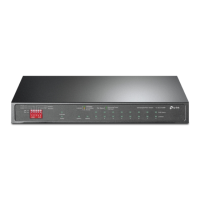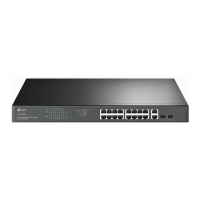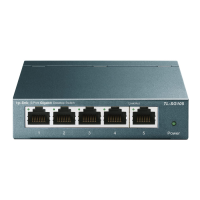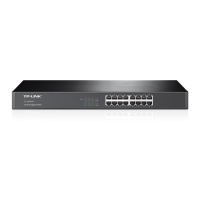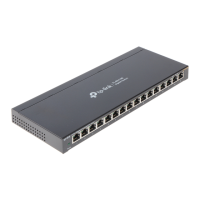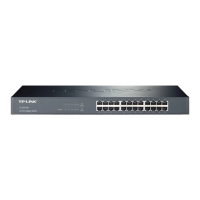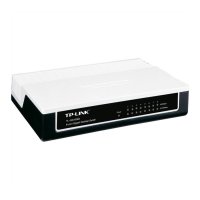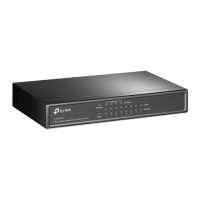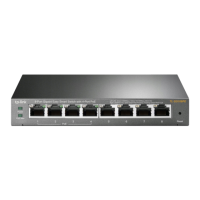Do you have a question about the TP-Link TL-SG1218MPE and is the answer not in the manual?
Specifies the intended audience for the user guide, focusing on network managers.
Explains the conventions used in the guide, including symbols, menu navigation, and formatting.
Provides links and references for additional resources, software, and support.
Provides a general overview of the Easy Smart Switch and its supported features.
Details the step-by-step process for accessing the switch's web interface.
Covers general system information viewing and basic parameter configuration.
Guides on viewing and specifying device description and system information.
Explains how to configure the switch's IP address using DHCP or manually.
Details how to modify the administrator's username and password.
Describes procedures for saving and restoring the switch's configuration.
Provides instructions for restarting the switch.
Details the process to reset the switch to its factory default settings.
Guides on how to update the switch's firmware.
Lists default parameter values for system configuration settings.
Introduces switching features like port settings, IGMP Snooping, and LAG.
Guides on configuring port status, speed, duplex mode, and flow control.
Explains how to enable and configure IGMP Snooping for multicast traffic management.
Details how to aggregate multiple physical ports into a logical link (LAG).
Provides practical examples for configuring switching-related features.
Lists default parameter values for switching configurations.
Introduces the monitoring feature for observing network traffic on the switch.
Explains how to view detailed traffic statistics for each network port.
Guides on setting up port mirroring to capture and analyze network traffic.
Details how to use the built-in cable test function to diagnose network cables.
Explains how to enable loop detection to prevent network loops.
Lists default parameter values for monitoring configurations.
Explains VLAN concepts and the three types of VLAN modes supported by the switch.
Guides on configuring the MTU VLAN mode, including setting the uplink port.
Details how to configure VLANs by assigning ports to specific VLANs.
Explains the configuration of 802.1Q VLAN tagging and PVID settings.
Provides a practical example for setting up 802.1Q VLANs in a network.
Lists default parameter values for VLAN configurations.
Introduces Quality of Service (QoS) concepts for managing network traffic.
Details how to configure QoS using Port Based, 802.1P, or DSCP modes.
Guides on setting ingress and egress bandwidth limits for switch ports.
Explains how to configure storm control to mitigate broadcast, multicast, and unicast storms.
Provides a practical example for configuring basic QoS for traffic prioritization.
Lists default parameter values for QoS configurations.
Introduces Power over Ethernet (PoE) and identifies supported switch models.
Details how to configure PoE settings, including power limits and port status.
Specifies the intended audience for the user guide, focusing on network managers.
Explains the conventions used in the guide, including symbols, menu navigation, and formatting.
Provides links and references for additional resources, software, and support.
Provides a general overview of the Easy Smart Switch and its supported features.
Details the step-by-step process for accessing the switch's web interface.
Covers general system information viewing and basic parameter configuration.
Guides on viewing and specifying device description and system information.
Explains how to configure the switch's IP address using DHCP or manually.
Details how to modify the administrator's username and password.
Describes procedures for saving and restoring the switch's configuration.
Provides instructions for restarting the switch.
Details the process to reset the switch to its factory default settings.
Guides on how to update the switch's firmware.
Lists default parameter values for system configuration settings.
Introduces switching features like port settings, IGMP Snooping, and LAG.
Guides on configuring port status, speed, duplex mode, and flow control.
Explains how to enable and configure IGMP Snooping for multicast traffic management.
Details how to aggregate multiple physical ports into a logical link (LAG).
Provides practical examples for configuring switching-related features.
Lists default parameter values for switching configurations.
Introduces the monitoring feature for observing network traffic on the switch.
Explains how to view detailed traffic statistics for each network port.
Guides on setting up port mirroring to capture and analyze network traffic.
Details how to use the built-in cable test function to diagnose network cables.
Explains how to enable loop detection to prevent network loops.
Lists default parameter values for monitoring configurations.
Explains VLAN concepts and the three types of VLAN modes supported by the switch.
Guides on configuring the MTU VLAN mode, including setting the uplink port.
Details how to configure VLANs by assigning ports to specific VLANs.
Explains the configuration of 802.1Q VLAN tagging and PVID settings.
Provides a practical example for setting up 802.1Q VLANs in a network.
Lists default parameter values for VLAN configurations.
Introduces Quality of Service (QoS) concepts for managing network traffic.
Details how to configure QoS using Port Based, 802.1P, or DSCP modes.
Guides on setting ingress and egress bandwidth limits for switch ports.
Explains how to configure storm control to mitigate broadcast, multicast, and unicast storms.
Provides a practical example for configuring basic QoS for traffic prioritization.
Lists default parameter values for QoS configurations.
Introduces Power over Ethernet (PoE) and identifies supported switch models.
Details how to configure PoE settings, including power limits and port status.
| Switching Capacity | 36 Gbps |
|---|---|
| MAC Address Table | 8K |
| Jumbo Frame | 9 KB |
| PoE Ports | 16 |
| PoE Standards | IEEE 802.3af/at |
| Dimensions | 440 x 180 x 44 mm |
| Operating Temperature | 0°C to 40°C |
| Power Supply | 100-240V~, 50/60Hz |
| Standards and Protocols | IEEE 802.3u |
| Network Media | 10BASE-T: UTP category 3, 4, 5 cable (maximum 100m) |
| Mounting | Rack Mountable |
| Storage Temperature | -40°C to 70°C |
| Operating Humidity | 10% to 90% (non-condensing) |
| Storage Humidity | 5% to 90% (non-condensing) |

